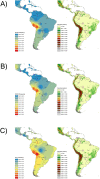Selection scan reveals three new loci related to high altitude adaptation in Native Andeans
- PMID: 30143708
- PMCID: PMC6109162
- DOI: 10.1038/s41598-018-31100-6
Selection scan reveals three new loci related to high altitude adaptation in Native Andeans
Abstract
The Andean Altiplano has been occupied continuously since the late Pleistocene, ~12,000 years ago, which places the Andean natives as one of the most ancient populations living at high altitudes. In the present study, we analyzed genomic data from Native Americans living a long-time at Andean high altitude and at Amazonia and Mesoamerica lowland areas. We have identified three new candidate genes - SP100, DUOX2 and CLC - with evidence of positive selection for altitude adaptation in Andeans. These genes are involved in the TP53 pathway and are related to physiological routes important for high-altitude hypoxia response, such as those linked to increased angiogenesis, skeletal muscle adaptations, and immune functions at the fetus-maternal interface. Our results, combined with other studies, showed that Andeans have adapted to the Altiplano in different ways and using distinct molecular strategies as compared to those of other natives living at high altitudes.
Conflict of interest statement
The authors declare no competing interests.
Figures



Similar articles
-
Human Genetic Adaptation to High Altitude: Evidence from the Andes.Genes (Basel). 2019 Feb 15;10(2):150. doi: 10.3390/genes10020150. Genes (Basel). 2019. PMID: 30781443 Free PMC article. Review.
-
Identifying signatures of natural selection in Tibetan and Andean populations using dense genome scan data.PLoS Genet. 2010 Sep 9;6(9):e1001116. doi: 10.1371/journal.pgen.1001116. PLoS Genet. 2010. PMID: 20838600 Free PMC article.
-
Natural Selection on Genes Related to Cardiovascular Health in High-Altitude Adapted Andeans.Am J Hum Genet. 2017 Nov 2;101(5):752-767. doi: 10.1016/j.ajhg.2017.09.023. Am J Hum Genet. 2017. PMID: 29100088 Free PMC article.
-
Identifying positive selection candidate loci for high-altitude adaptation in Andean populations.Hum Genomics. 2009 Dec;4(2):79-90. doi: 10.1186/1479-7364-4-2-79. Hum Genomics. 2009. PMID: 20038496 Free PMC article.
-
Measuring high-altitude adaptation.J Appl Physiol (1985). 2017 Nov 1;123(5):1371-1385. doi: 10.1152/japplphysiol.00321.2017. Epub 2017 Aug 31. J Appl Physiol (1985). 2017. PMID: 28860167 Free PMC article. Review.
Cited by
-
Genetic Signatures of Positive Selection in Human Populations Adapted to High Altitude in Papua New Guinea.Genome Biol Evol. 2024 Aug 5;16(8):evae161. doi: 10.1093/gbe/evae161. Genome Biol Evol. 2024. PMID: 39173139 Free PMC article.
-
Genetic differentiation in East African ethnicities and its relationship with endurance running success.PLoS One. 2022 May 19;17(5):e0265625. doi: 10.1371/journal.pone.0265625. eCollection 2022. PLoS One. 2022. PMID: 35588128 Free PMC article.
-
Hypoxia and Inflammation: Insights From High-Altitude Physiology.Front Physiol. 2021 May 26;12:676782. doi: 10.3389/fphys.2021.676782. eCollection 2021. Front Physiol. 2021. PMID: 34122145 Free PMC article. Review.
-
The genetic structure and adaptation of Andean highlanders and Amazonians are influenced by the interplay between geography and culture.Proc Natl Acad Sci U S A. 2020 Dec 22;117(51):32557-32565. doi: 10.1073/pnas.2013773117. Epub 2020 Dec 4. Proc Natl Acad Sci U S A. 2020. PMID: 33277433 Free PMC article.
-
Human Genetic Adaptation to High Altitude: Evidence from the Andes.Genes (Basel). 2019 Feb 15;10(2):150. doi: 10.3390/genes10020150. Genes (Basel). 2019. PMID: 30781443 Free PMC article. Review.
References
-
- Espinoza-Navarro O, Díaz J, Rodríguez H, Moreno A. Effects of altitude on anthropometric and physiological patterns in Aymara and non-Aymara population between 18 and 65 years in the province of Parinacota Chile (3.700 masl) Int. J. Morphol. 2011;29:34–40. doi: 10.4067/S0717-95022011000100005. - DOI
Publication types
MeSH terms
LinkOut - more resources
Full Text Sources
Other Literature Sources
Research Materials
Miscellaneous

